Enhanced Hybrid Nanogenerator Based on PVDF-HFP and PAN/BTO Coaxially Structured Electrospun Nanofiber
Abstract
1. Introduction
2. Results and Discussion
3. Materials and Methods
3.1. Materials (Solution Preparation)
3.2. Coaxial Electrospinning Process
3.3. Characterization Techniques (Cyclic Tensile Tests)
4. Conclusions
Supplementary Materials
Author Contributions
Funding
Data Availability Statement
Acknowledgments
Conflicts of Interest
References
- Elda, M.M.-M.; Rodrigo, M.-G.; Alonso, M.-B.; Hafiz, M.N.I.; Juan Eduardo, S.-H.; Roberto, P.-S. Environmental impact of emerging contaminants from battery waste: A mini review. Case Stud. Chem. Environ. Eng. 2021, 3, 100104. [Google Scholar]
- Yoo, J.-U.; Kim, D.-H.; Choi, T.-M.; Jung, E.-S.; Lee, H.-R.; Lee, C.-Y.; Pyo, S.-G. Advancements in Flexible Nanogenerators: Polyvinylidene Fluoride-Based Nanofiber Utilizing Electrospinning. Molecules 2024, 29, 3576. [Google Scholar] [CrossRef] [PubMed]
- Rahmani, H.; Shetty, D.; Wagih, M.; Ghasempour, Y.; Palazzi, V.; Carvalho, N.B.; Correia, R.; Costanzo, A.; Vital, D.; Alimenti, F.; et al. Next-Generation IoT Devices: Sustainable Eco-Friendly Manufacturing, Energy Harvesting, and Wireless Connectivity. IEEE J. Microw. 2023, 3, 237–255. [Google Scholar] [CrossRef]
- Saravanakumar, B.; Mohan, R.; Thiyagarajan, K.; Kim, S.J. Fabrication of a ZnO nanogenerator for eco-friendly biomechanical energy harvesting. RSC Adv. 2013, 3, 16646. [Google Scholar] [CrossRef]
- Vladislav, S.; Svitlana, K.; Soares dos Santos, M.P.; Andrei, L.K. Natural and Eco-Friendly Materials for Triboelectric Energy Harvesting. Nano-Micro Lett. 2020, 12, 42. [Google Scholar]
- Derkus, B. Applying the miniaturization technologies for biosensor design. Biosens. Bioelectron. 2016, 79, 901. [Google Scholar] [CrossRef]
- Song, S.; Ai, H.; Zhu, W.; Qiu, F.; Wang, Y.; Zhou, J. Eco-friendly electrospun nanofibrous membranes with high thermal energy capacity and improved thermal transfer efficiency. Renew. Energy 2020, 148, 504. [Google Scholar] [CrossRef]
- Wang, J.; Wang, Z.; Ni, J.; Li, L. Electrospinning for flexible sodium-ion batteries. Energy Storage Mater. 2022, 45, 704–719. [Google Scholar] [CrossRef]
- Bairagi, S.; Ali, S.W. A hybrid piezoelectric nanogenerator comprising of KNN/ZnO nanorods incorporated PVDF electrospun nanocomposite webs. Int. J. Energy Res. 2020, 44, 5545–5563. [Google Scholar] [CrossRef]
- Yoo, J.; Kim, D.H.; Pyo, S.G. Eletrospinning: Improving the Performance of 1-D Nanofibers Used in Anodes, Cathodes, and Separators in Lithium-Ion Batteries. Int. J. Energy Res. 2024, 2024, 1847943. [Google Scholar] [CrossRef]
- Jihyeon, P.; Seungju, J.; Youngsu, K.; Shakir, Z.; Daewon, K. Electrospun Nanofiber Covered Polystyrene Micro-Nano Hybrid Structures for Triboelectric Nanogenerator and Supercapacitor. Micromachines 2022, 13, 380. [Google Scholar] [CrossRef] [PubMed]
- Duc-Nam, N.; Wonkyu, M. Significant Electromechanical Characteristic Enhancement of Coaxial Electrospinning Core–Shell Fibers. Polymers 2022, 14, 1739. [Google Scholar] [CrossRef] [PubMed]
- Sharafkhani, S.; Kokabi, M. Ultrathin-shell PVDF/CNT nanocomposite aligned hollow fibers as a sensor/actuator single element. Compos. Sci. Technol. 2020, 200, 108425. [Google Scholar] [CrossRef]
- Gulnur, K.; Nursultan, T.; Ingkar, A.; Alisher, M.; Arailym, N.; Desmond, A.; Zhumabay, B. A Review of Piezoelectric PVDF Film by Electrospinning and Its Applications. Sensors 2020, 20, 5214. [Google Scholar] [CrossRef]
- Wu, L.; Jin, Z.; Liu, Y.; Ning, H.; Liu, X.; Alamusi; Hu, N. Recent advances in the preparation of PVDF-based piezoelectric materials. Nanotechnol. Rev. 2022, 11, 1386–1407. [Google Scholar] [CrossRef]
- Tao, J.; Wang, Y.; Zheng, X.; Zhao, C.; Jin, X.; Wang, W.; Lin, T. A review: Polyacrylonitrile as high-performance piezoelectric materials. Nano Energy 2023, 118, 108987. [Google Scholar] [CrossRef]
- Yu, S.; Milam-Guerrero, J.; Tai, Y.; Yang, S.; Choi, Y.Y.; Nam, J.; Myung, N.V. Maximizing Polyacrylonitrile Nanofiber Piezoelectric Properties through the Optimization of Electrospinning and Post-thermal Treatment Processes. ACS Appl. Polym. Mater. 2022, 4, 635–644. [Google Scholar] [CrossRef]
- Deng, W.; Zhou, Y.; Libanori, A.; Chen, G.; Yang, W.; Chen, J. Piezoelectric nanogenerators for personalized healthcare. Chem. Soc. Rev. 2022, 51, 3380. [Google Scholar] [CrossRef] [PubMed]
- Le, A.T.; Ahmadipour, M.; Pung, S.-Y. A review on ZnO-based piezoelectric nanogenerators: Synthesis, characterization techniques, performance enhancement and applications. J. Alloys Compd. 2020, 844, 156172–156194. [Google Scholar] [CrossRef]
- Khandelwal, G.; Raj, N.P.M.J.; Kim, S.-J. Triboelectric nanogenerator for healthcare and biomedical applications. Nano Today 2020, 33, 100882–100910. [Google Scholar] [CrossRef]
- Luo, J.; Gao, W.; Wang, Z.L. The Triboelectric Nanogenerator as an Innovative Technology toward Intelligent Sports. Adv. Mater. 2021, 33, e2004178. [Google Scholar] [CrossRef]
- Luo, J.; Wang, Z.L. Recent progress of triboelectric nanogenerators: From fundamental theory to practical applications. EcoMat 2020, 2, e12059. [Google Scholar] [CrossRef]
- Dongjie, J.; Han, O.; Bojing, S.; Yang, Z.; Puchuan, T.; Xuecheng, Q.; Shengyu, C.; Yuan, X.; Chaochao, Z.; Yubo, F.; et al. A wearable noncontact free-rotating hybrid nanogenerator for self-powered electronics. InfoMat 2020, 2, 1191–1200. [Google Scholar]
- Kang, X.; Jia, S.; Lin, Z.; Zhang, H.; Wang, L.; Zhou, X. Flexible wearable hybrid nanogenerator to harvest solar energy and human kinetic energy. Nano Energy 2022, 103, 107808. [Google Scholar] [CrossRef]
- Patnam, H.; Dudem, B.; Alluri, N.R.; Mule, A.R.; Graham, S.A.; Kim, S.-J.; Yu, J.S. Piezo/triboelectric hybrid nanogenerators based on Ca-doped barium zirconate titanate embedded composite polymers for wearable electronics. Compos. Sci. Technol. 2020, 188, 107963. [Google Scholar] [CrossRef]
- Evans, H. An X-ray diffraction study of tetragonal barium titanate. Acta Crystallogr. 1961, 14, 1019–1026. [Google Scholar] [CrossRef]
- Yuan, D.; Fan, X.; Sun, J.; Li, H.; He, C.; Li, Z.; Thitsartarn, W. β phase PVDF-hfp induced by mesoporous SiO2 nanorods: Synthesis and formation mechanism. J. Mater. Chem. C 2015, 3, 3708. [Google Scholar] [CrossRef]
- Sergey, V.P.; Alexey, A.B.; Alexander, V.E.; Dmitry, G.B.; Ivan, S.S. Effect of Polymer Matrix on Inelastic Strain Development in PI- and PEI-Based Composites Reinforced with Short Carbon Fibers under Low-Cyclic Fatigue. Polymers 2023, 15, 1228. [Google Scholar] [CrossRef] [PubMed]
- Williams, M.W. Triboelectric charging of insulating polymers–some new perspectives. Aip Adv. 2012, 2, 010701. [Google Scholar] [CrossRef]
- Mu, J.; Xian, S.; Yu, J.; Li, Z.; Zhao, J.; Zhong, J.; Han, X.; Hou, X.; He, J.; Chou, X. Flexible and wearable BaTiO3/polyacrylonitrile-based piezoelectric sensor for human posture monitoring. Sci. China Technol. Sci. 2022, 65, 858–869. [Google Scholar] [CrossRef]
- Yu, J.; Xian, S.; Zhang, Z.; Hou, X.; He, J.; Mu, J.; Geng, W.; Qiao, X.; Zhang, L.; Chou, X. Synergistic piezoelectricity enhanced BaTiO3/polyacrylonitrile elastomer-based highly sensitive pressure sensor for intelligent sensing and posture recognition applications. Nano Res. 2023, 16, 5490–5502. [Google Scholar] [CrossRef]
- Gade, H.; Nikam, S.; Chase, G.G.; Reneker, D.H. Effect of electrospinning conditions on β-phase and surface charge potential of PVDF fibers. Polymer 2021, 228, 123902. [Google Scholar] [CrossRef]
- Zhongchen, H.; François, R.; Maryline, L.; Elham, M.; Fabien, S. Electrospun PVDF Nanofibers for Piezoelectric Applications: A Review of the Influence of Electrospinning Parameters on the β Phase and Crystallinity Enhancement. Polymers 2021, 13, 174. [Google Scholar] [CrossRef] [PubMed]
- Pan, S.; Zhang, Z. Triboelectric effect: A new perspective on electron transfer process. J. Appl. Phys. 2017, 122, 144302–144312. [Google Scholar] [CrossRef]
- Pan, S.; Zhang, Z. Fundamental theories and basic principles of triboelectric effect: A review. Friction 2019, 7, 2. [Google Scholar] [CrossRef]

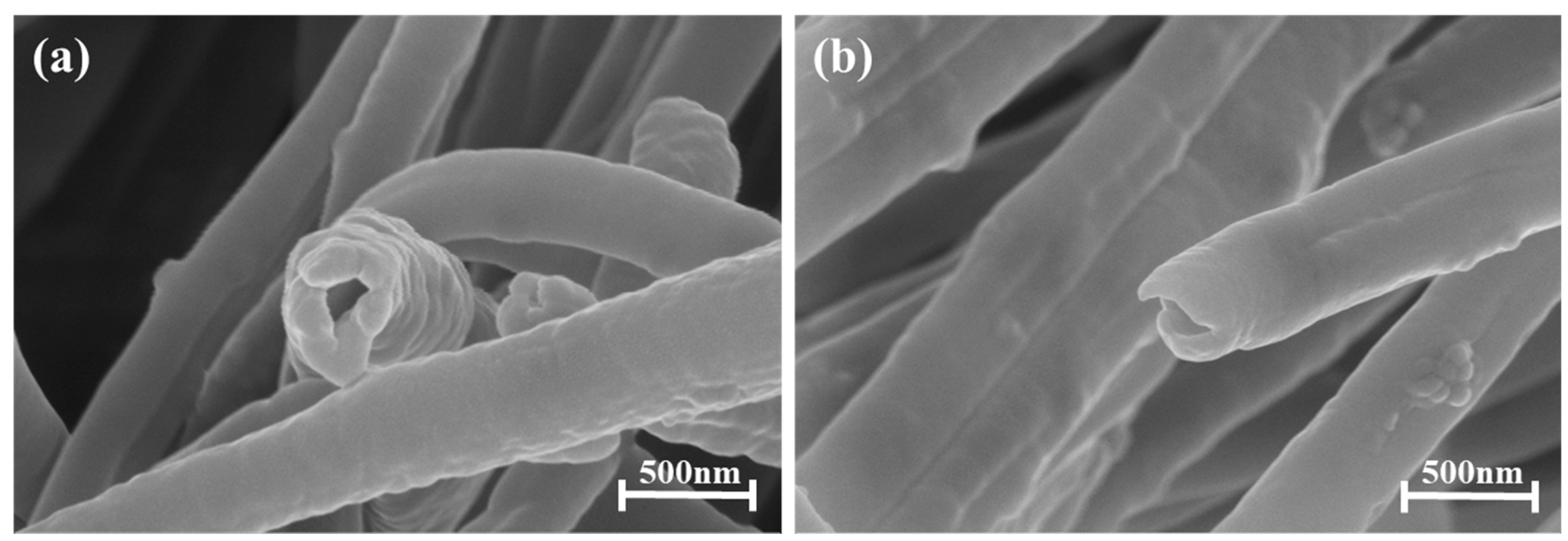
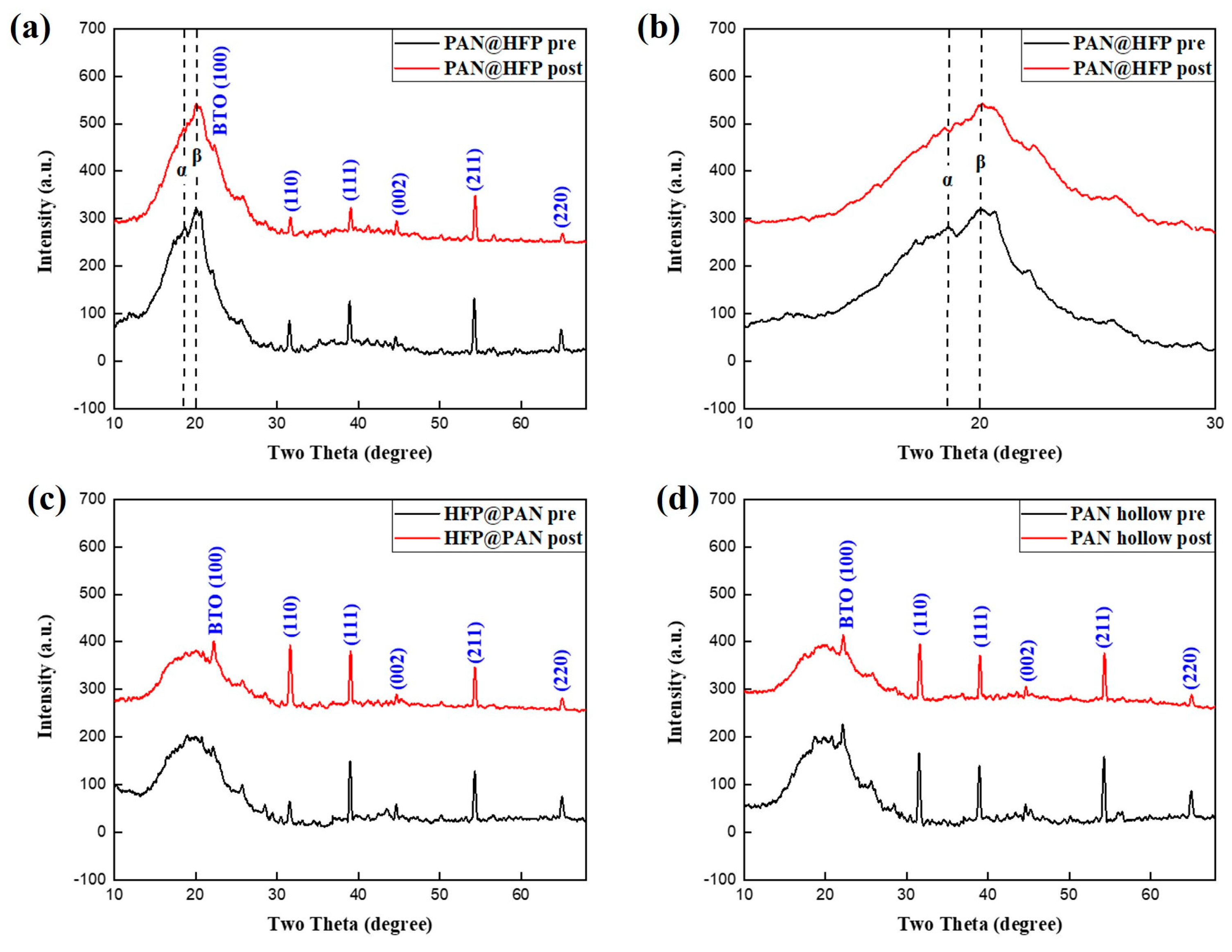
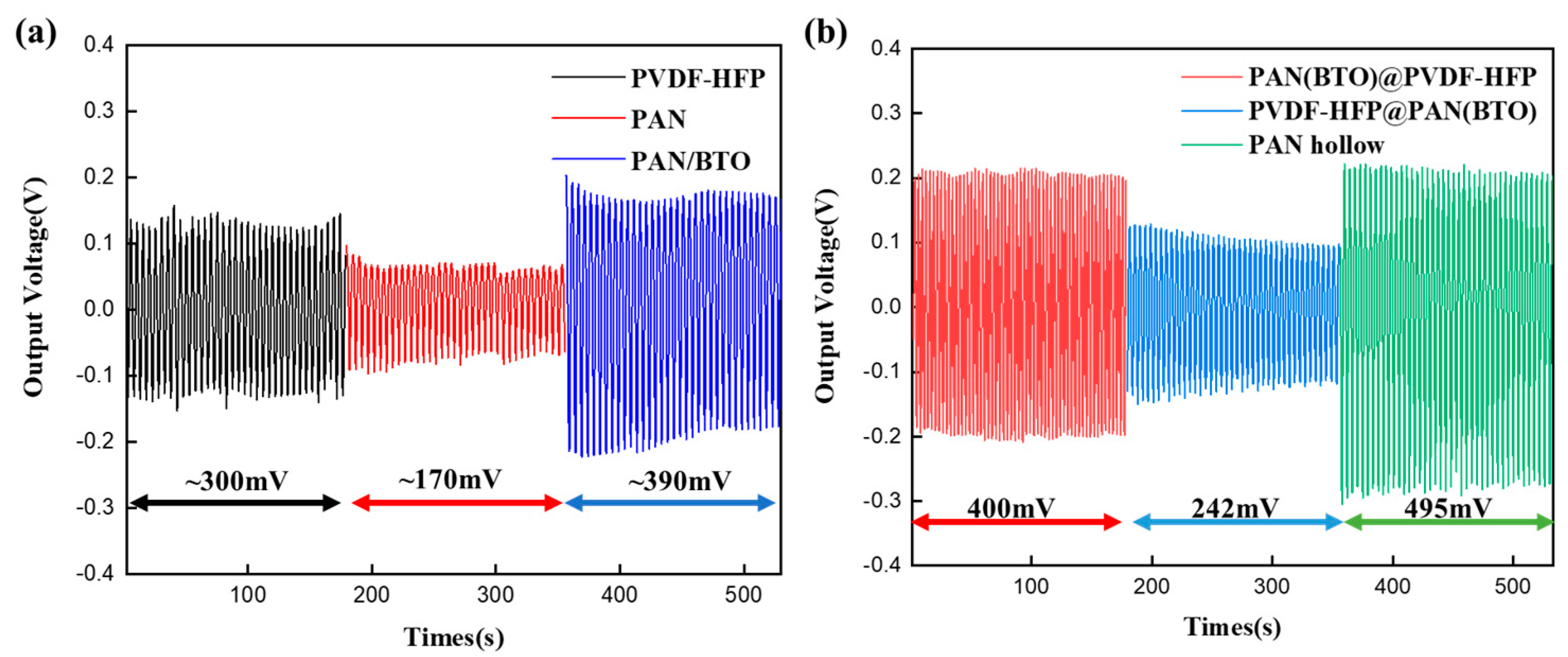
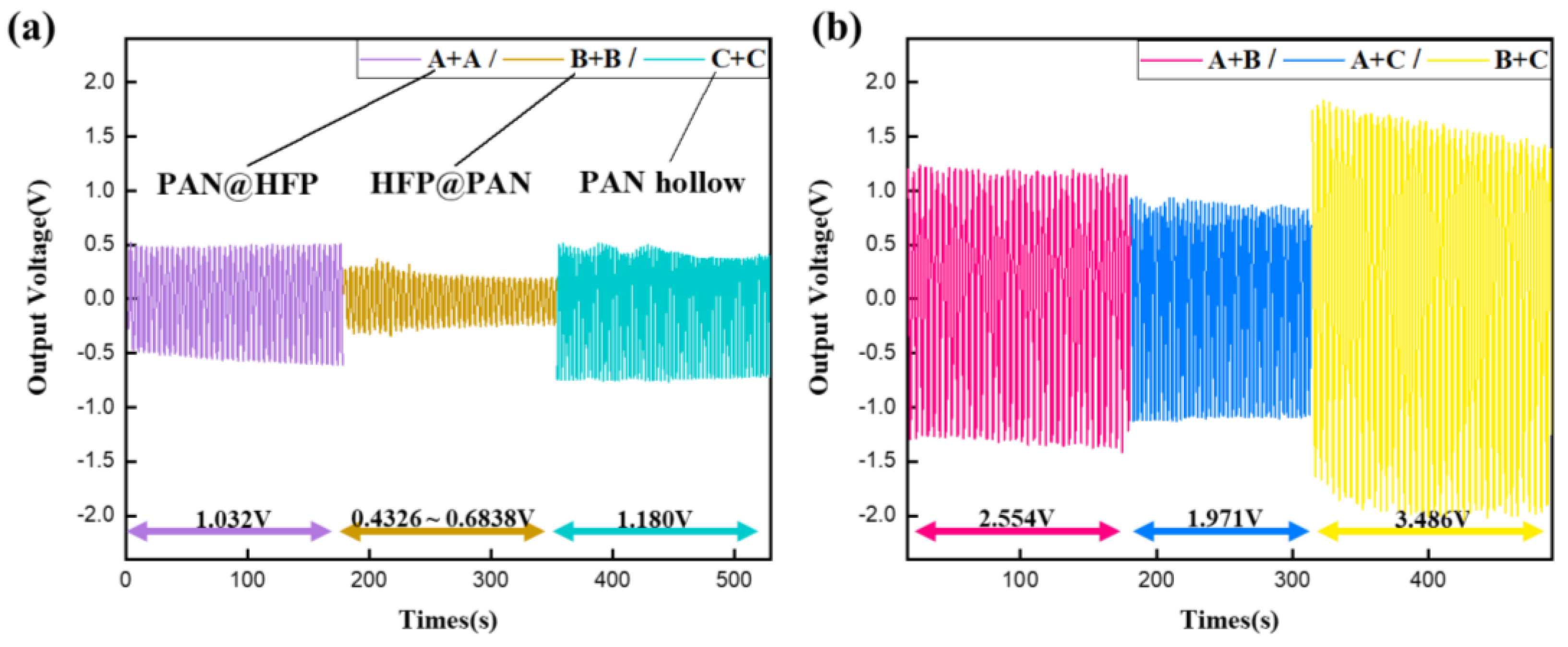

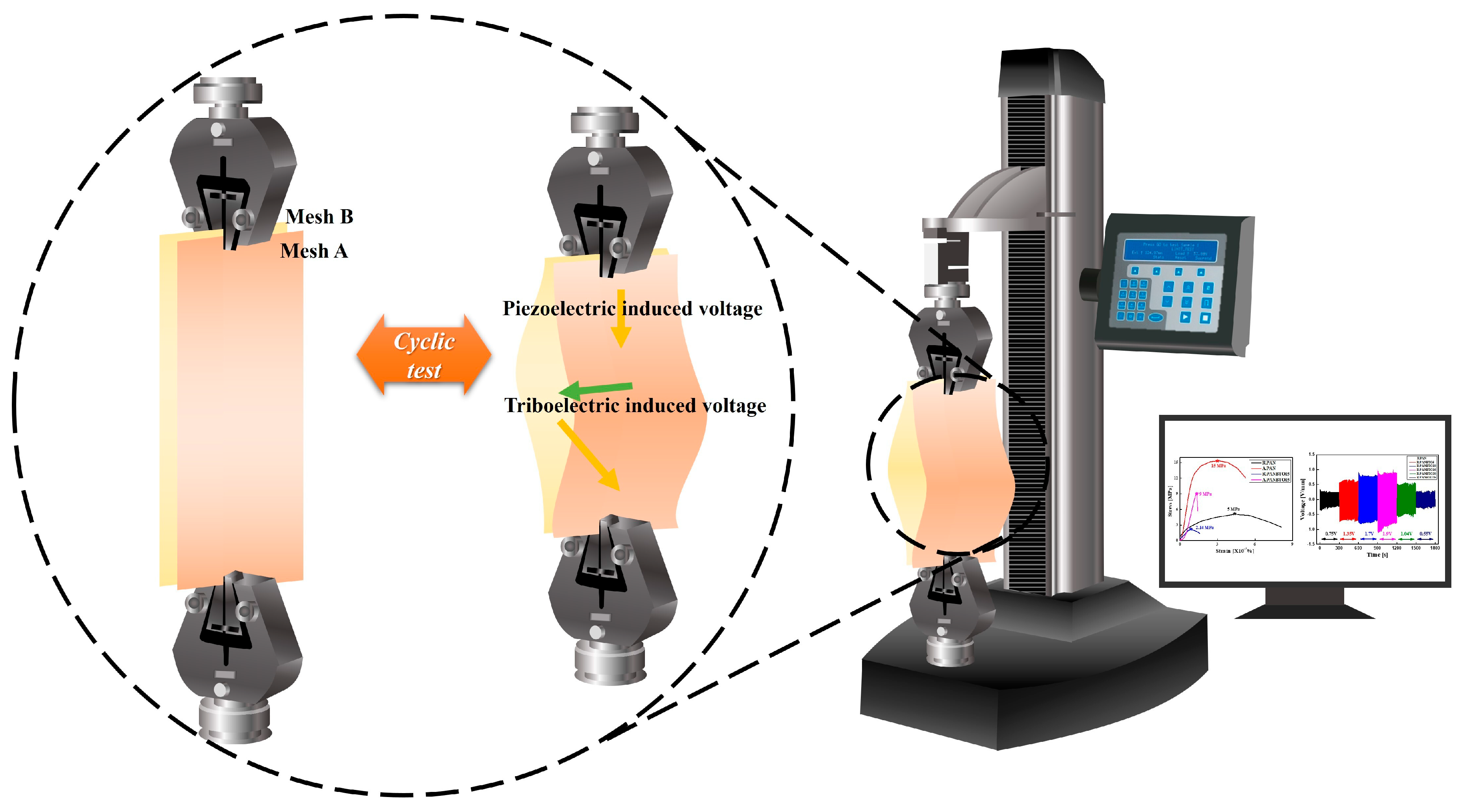
| Combination | A + A | B + B | C + C | A + B | A + C | B + C |
|---|---|---|---|---|---|---|
| Range of Output Voltage | 0.958~1.107 V | 0.433~0.612 V | 1.098~1.262 V | 2.513~2.596 V | 1.883~2.059 V | 3.431~3.541 V |
| Median of Voltage | 1.033 V | 0.523 V | 1.180 V | 2.555 V | 1.971 V | 3.486 V |
| Magnification | 1.198~1.384 | 0.894~1.264 | 1.109~1.275 | 3.914~4.044 | 2.104~2.301 | 4.655~4.805 |
Disclaimer/Publisher’s Note: The statements, opinions and data contained in all publications are solely those of the individual author(s) and contributor(s) and not of MDPI and/or the editor(s). MDPI and/or the editor(s) disclaim responsibility for any injury to people or property resulting from any ideas, methods, instructions or products referred to in the content. |
© 2024 by the authors. Licensee MDPI, Basel, Switzerland. This article is an open access article distributed under the terms and conditions of the Creative Commons Attribution (CC BY) license (https://creativecommons.org/licenses/by/4.0/).
Share and Cite
Yoo, J.-U.; Kim, D.-H.; Jung, E.-S.; Choi, T.-M.; Lee, H.-R.; Pyo, S.-G. Enhanced Hybrid Nanogenerator Based on PVDF-HFP and PAN/BTO Coaxially Structured Electrospun Nanofiber. Micromachines 2024, 15, 1171. https://doi.org/10.3390/mi15091171
Yoo J-U, Kim D-H, Jung E-S, Choi T-M, Lee H-R, Pyo S-G. Enhanced Hybrid Nanogenerator Based on PVDF-HFP and PAN/BTO Coaxially Structured Electrospun Nanofiber. Micromachines. 2024; 15(9):1171. https://doi.org/10.3390/mi15091171
Chicago/Turabian StyleYoo, Jin-Uk, Dong-Hyun Kim, Eun-Su Jung, Tae-Min Choi, Hwa-Rim Lee, and Sung-Gyu Pyo. 2024. "Enhanced Hybrid Nanogenerator Based on PVDF-HFP and PAN/BTO Coaxially Structured Electrospun Nanofiber" Micromachines 15, no. 9: 1171. https://doi.org/10.3390/mi15091171
APA StyleYoo, J.-U., Kim, D.-H., Jung, E.-S., Choi, T.-M., Lee, H.-R., & Pyo, S.-G. (2024). Enhanced Hybrid Nanogenerator Based on PVDF-HFP and PAN/BTO Coaxially Structured Electrospun Nanofiber. Micromachines, 15(9), 1171. https://doi.org/10.3390/mi15091171






